
by Jane McCurry | Apr 25, 2019 | Renewables, Solar, Utilities, Wind
Across America, businesses are increasingly investing in clean, renewable energy. They know that the costs for wind and solar have plummeted, allowing the companies to take advantage of the low-cost electricity from renewables. In addition, customers, employees, and investors are increasingly looking to these businesses to make bigger commitments to improving their impacts on the world around us.
Over the past year, Chris Deisinger has acted as a consultant to RENEW Wisconsin to gather up all these corporate commitments to renewable energy, and do a deep dive into which of these national and multi-national firms have Wisconsin operations.
Today, we’re very excited to show you which of these national leaders have Wisconsin operations – and it’s a great list! These are companies who, over the coming years, will be searching for options to access renewable energy to cover the needs of their Wisconsin operations.
Corporations with Renewable Commitments & Wisconsin Operations
A timely example of renewable energy commitments in Wisconsin is Ashley Furniture, headquartered in Arcadia, Wisconsin. On Wednesday, Ashley announced a $29 million investment in renewable energy. The investment will be used to offset 35% of their energy use by installing solar panels at 10 of their largest facilities. Ashley expects to save at least $5 million in the first year.
Dozens of other companies in Wisconsin have also made commitments to renewable energy, including:
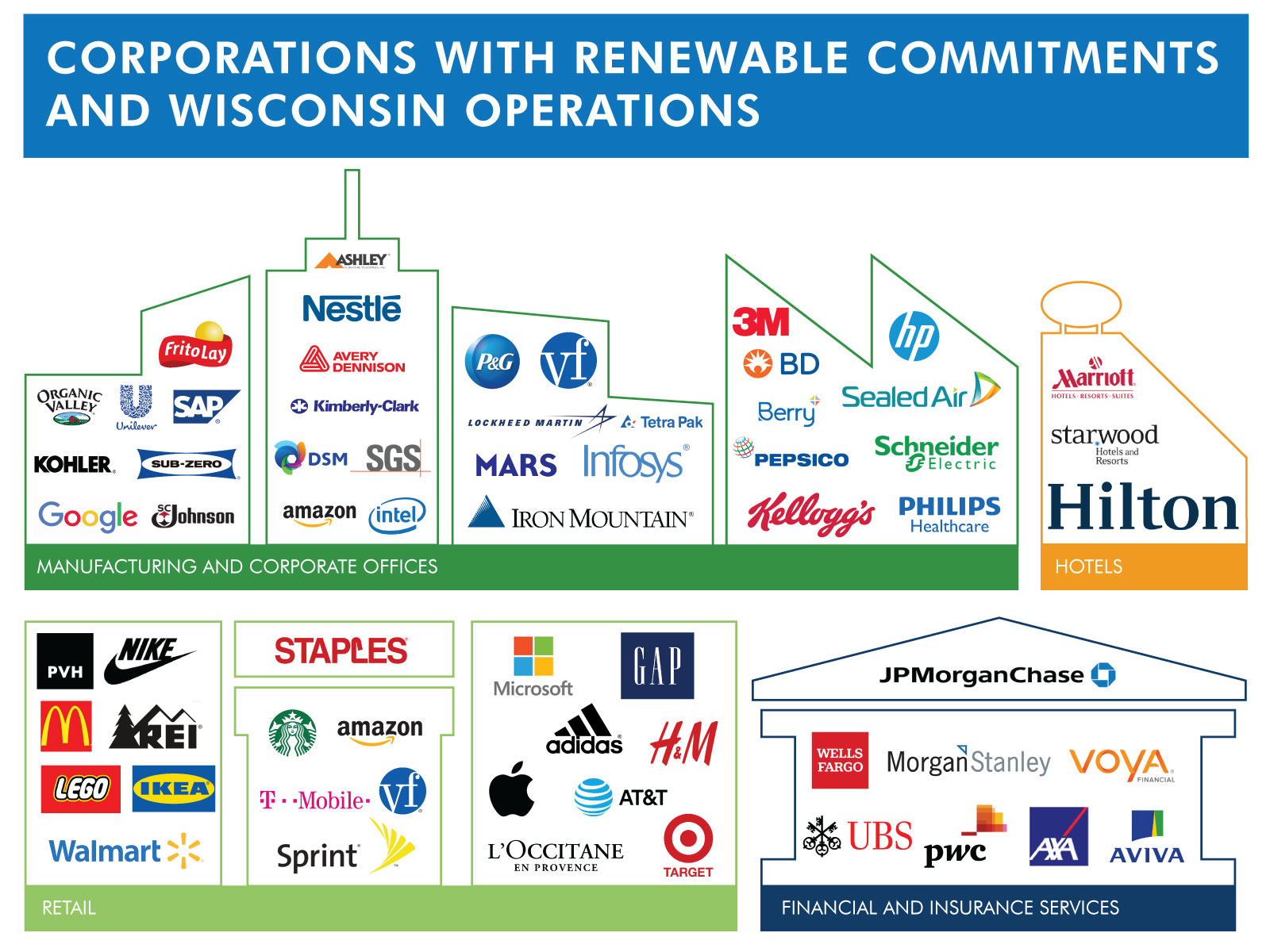
Utility Programs to Connect Commercial Customers with Renewable Energy
Wisconsin power companies are starting to put together programs to help companies like these, and other large customers, meet their renewable energy goals.
Two years ago, Madison Gas & Electric debuted a “Renewable Energy Rider” special service for its commercial customers, and just last month they announced they had the first two customers express interest.
Last fall, We Energies followed suit by proposing and gaining approval for a similar program that would enable their larger customers to sign up for access to dedicated renewable energy resources. We Energies was granted approval for their program in December 2018.
And, just a few weeks ago, Alliant Energy joined in, proposing a similar program again. Alliant’s program still requires approval from the Public Service Commission which oversees and regulates the utilities in Wisconsin.
A Brighter Future
Hopefully you caught Budweiser’s Super Bowl Commercial featuring their commitment to making every Budweiser with 100% wind energy. These are the types of success stories that can happen in Wisconsin too.
With dozens of corporations committing to renewable energy, and the utility programs to provide it, the future of renewables for Wisconsin is looking bright.
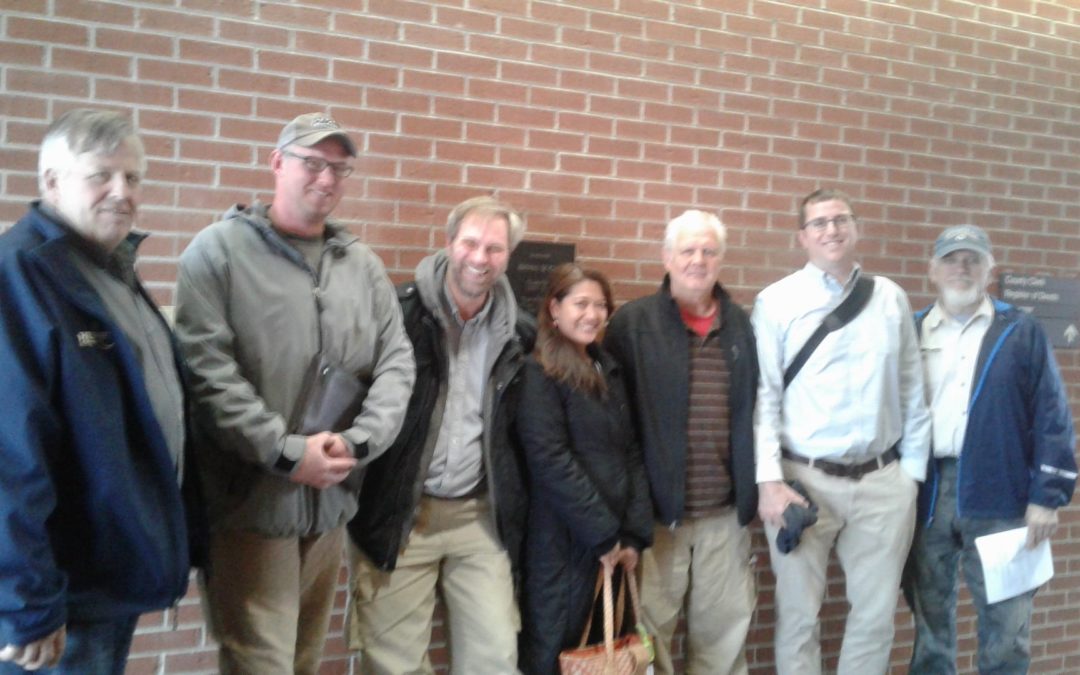
by Heather Allen | Apr 17, 2019 | Jobs, Local Government, Renewables, Solar, Utility Scale
On Wednesday, April 10, the Richland County Zoning and Land Information Committee unanimously voted to usher in a brand new, nearly 50 megawatt solar farm!
Located two miles north of the Wisconsin River on agricultural lands owned by three local families, the Richland County Solar Farm will sit on roughly 500 acres. With a capacity of 49.9 megawatts (MW), the project is expected to produce enough electricity to offset the consumption from more than 13,000 average Wisconsin homes.
This project’s approval kicked off a momentous week for solar energy in Wisconsin when, the very next day, the Public Service Commission of Wisconsin approved two additional solar farm projects totaling 450 megawatts. You can read about Badger Hollow and the Two Creeks solar farm approvals here.
Wisconsin’s current fleet of solar farms range from one to five MW in size. After the Richland County vote and the subsequent decisions at the PSC, it is clear that large-scale projects are coming to Wisconsin. Scaling up to a renewable energy economy will require investments in utility-scale wind and solar projects like the Richland County Solar Farm.
This is the first solar project of this size to be approved at the county level. Richland officials took their time to carefully review the project proposal. The developer, Savion Energy (formerly Tradewind Energy), held two community meetings in September and November in the Village of Lone Rock. The County Zoning and Land Information Committee also heard from the public at two meetings in November 2018 and the most recent meeting in April 2019.
At these meetings, residents from Richland County brought up the need for local jobs and the economic investment the farm would bring, the need for clean energy, their concerns about climate change, as well as concerns for future generations. Minutes before the final vote, local resident Bob Simpson expressed support for the project by highlighting his worries for his grandchildren and that at some point “we are going to run out of gas.” But there were other residents who expressed concern about potential issues related to glare, aesthetics and the use of agricultural land for solar.
Bearing in mind the concerns raised in the public meetings, the final conditions for the Richland County Solar Farm Conditional Use Permit project include the following developer obligations:
- Create a vegetative barrier between project lots and adjacent residences within 1000 feet of the project fence.
- Provide screening on State Route 130 (which runs through the project site) within 1000 feet of the project fence.
- Provide a detailed site plan including access and driveway permits.
- Provide a decommissioning plan and financial security for decommissioning.
Immediately after the meeting, I caught up with Marc Couey, Richland County Supervisor and member of the Zoning and Land Information Committee. I asked him about the Richland County Solar Farm and he said, “We are going to run out of power without using alternative energies. It’s the right thing to do.” I couldn’t agree more!
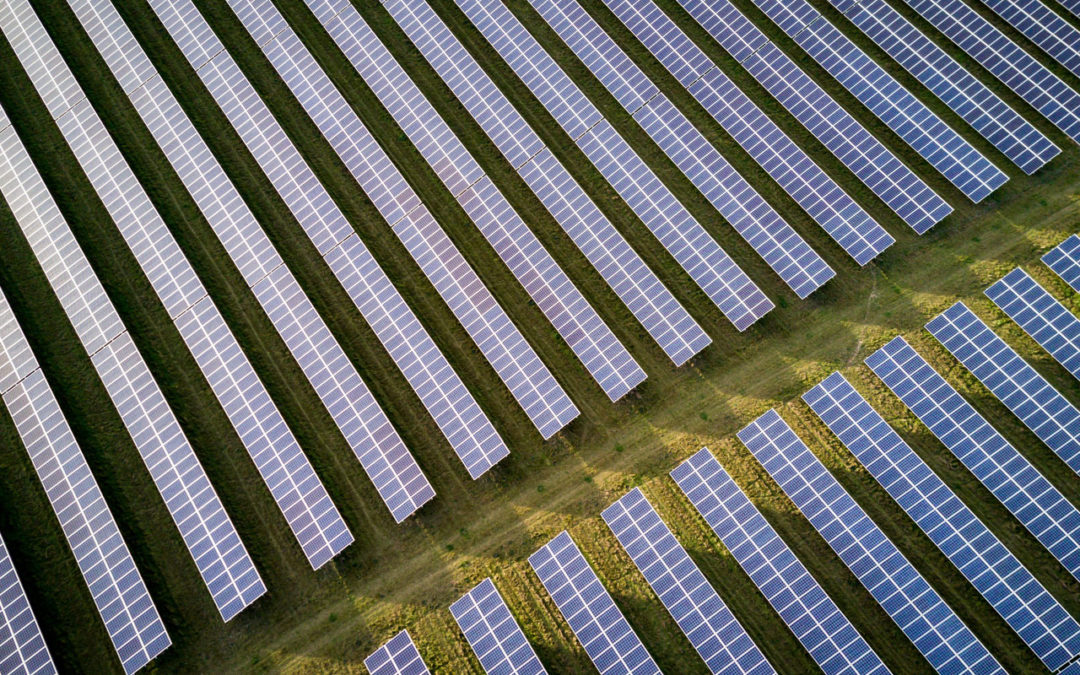
by Tyler Huebner | Apr 11, 2019 | Public Service Commission, Renewables, Solar, Utilities, Utility Scale
Today at its Open Meeting, the Wisconsin Public Service Commission approved five interrelated cases that will lead to a five-fold expansion of solar energy in Wisconsin.
The PSC approved:
- The Badger Hollow Solar Farm project in Iowa County, totaling 300 megawatts. Badger Hollow could become the largest solar electric plant in the Midwest when completed. In addition, the PSC approved a “tie line” that will deliver Badger Hollow’s output to a nearby substation, where it will be injected into the existing southwest Wisconsin grid.
- The Two Creeks Solar Project in Manitowoc County, totaling 150 megawatts. As with Badger Hollow, the PSC also approved a “tie line” that will deliver Two Creeks’ output to a nearby substation.
- Finally, the PSC approved an application from two Wisconsin utilities, Wisconsin Public Service based in Green Bay and Madison Gas & Electric, to acquire a total of 300 megawatts of this new solar capacity. The utilities will acquire the entire Two Creeks Solar Farm and a 150 MW share of the Badger Hollow Solar Farm. Wisconsin Public Service will acquire a total of 200 MW and Madison Gas & Electric will acquire 100 MW.
By RENEW Wisconsin’s estimates, the state of Wisconsin closed 2018 with about 103 megawatts of solar power, about 80% of that residing on homes and buildings, directly serving the customers who bought the solar arrays.
When completed, the 450 megawatts of solar would produce about 1.3% of Wisconsin’s annual electricity consumption, and supply electricity equivalent to the usage of about 116,500 Wisconsin homes. Both projects should be operational by mid-2021.
RENEW Wisconsin’s Executive Director, Tyler Huebner, said, “We are very happy to see the Public Service Commission approve these solar projects and find that it is cost-effective for two of our major utilities to own and operate these plants. It is a landmark day for solar energy in Wisconsin. Solar energy is a smart choice to meet the electricity needs of our citizens, businesses, and organizations, and without a state mandate to do so. With solar energy, we will produce homegrown, healthy energy right here in Wisconsin for years to come, and provide substantial economic benefits to the landowners and local governments who will host these projects.”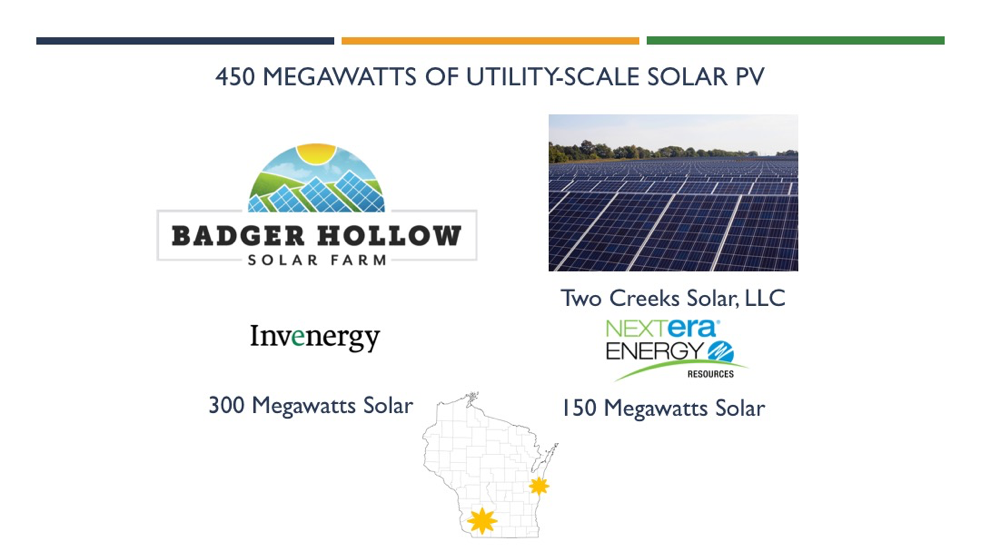
Today’s approvals build momentum for large-scale solar as a resource for power suppliers and utilities in Wisconsin.
- Three weeks ago, Dairyland Power Cooperative announced a commitment to purchase electricity from a 149 megawatt solar facility called Badger State Solar that would be located in Jefferson County. That project is subject to PSC approval as well.
- Just yesterday, April 10, the Richland County Board of Zoning gave final, and unanimous, approval to the 49.9 megawatt Richland County Solar Project developed by Savion Energy to be located in the Town of Buena Vista.
- In 2017, WPPI Energy announced it would purchase power from a 100 megawatt solar project near the Point Beach Nuclear Station. That project also will seek PSC approval in 2019.
Taken together, these five new solar projects account for approximately 749 megawatts of new solar power. If all are approved and built, they would supply 2.1% of Wisconsin’s annual electricity needs, and produce enough power to equal the annual usage of about 185,000 homes in Wisconsin. Beyond these projects, at least 4,000 megawatts of additional large-scale solar projects are being explored and developed in Wisconsin. We encourage you to learn more about large-scale solar energy, including our long list of questions and answers, at www.renewwisconsin.org/solarfarms.
About RENEW Wisconsin
RENEW Wisconsin is a nonprofit organization which promotes renewable energy in Wisconsin. We work on policies and programs that support solar power, wind power, biogas, local hydropower, geothermal energy, and electric vehicles in Wisconsin. More information is available on RENEW’s website: www.renewwisconsin.org.
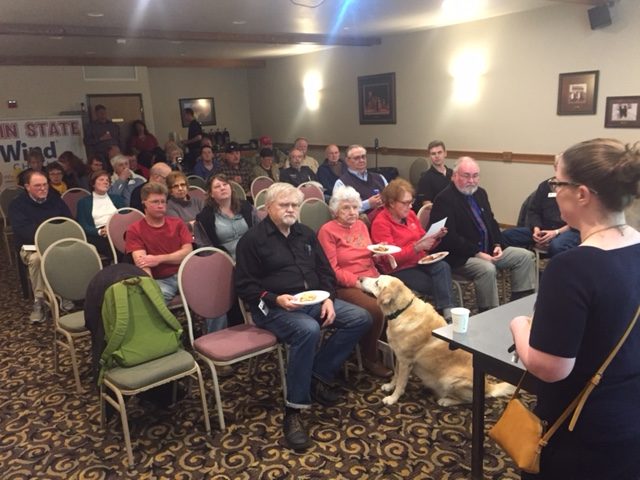
by Heather Allen | Apr 5, 2019 | Local Initiatives, RENEW Wisconsin, Renewables, Wind
On Monday March 25th RENEW Wisconsin facilitated a Wind Energy Education Event in Monroe, Wisconsin to answer questions from local residents about wind energy and new wind projects being proposed in Lafayette and Green Counties.
The Wind Education Event was hosted by Art Bartsch, local entrepreneur, green businesses innovator, and proprietor of the Monroe Super 8 Motel. Tyler Huebner, Executive Director of RENEW Wisconsin, kicked off the event with an overview of wind energy in Wisconsin. Then a panel of local experts including Mayor Dave Breunig (City of Darlington), Alder Steve Pickett (Darlington), and Tim McComish (Chair of Seymour Township Board), discussed their experiences with the Quilt Block Wind Farm located in neighboring Lafayette County. The event concluded with a demonstration of the power of wind energy from Dick Anderson and the student scientists of Kid Wind. Brodie Dockendorf (EDP Renewables) was also in attendance and addressed many technical questions about how wind turbines work. You can watch the video of the entire event on our Facebook page at this link.
Energized in 2017 and located wholly within Seymour Township in Lafayette County, Quilt Block serves as an excellent case study for future wind farms in the area. Quilt Block is a wind farm comprised of 49 modern turbines able to generate up to 2 MW each. Forthcoming wind farm projects planned in Wisconsin are likely to use similar scale or slightly larger turbines. The Sugar River Wind Farm proposed for southern Green County would host turbines with capacities of 2.625 MW and 2.75 MW.
The Quilt Block Wind Farm offers many economic benefits to Lafayette County. According to Mayor Dave Bruenig and Alderman Steve Pickett, the project construction supported local businesses through a variety of activities including the construction of a $700,000 warehouse and office space, the presence of the construction crews, and the full-time employees who purchased homes in the community. Mayor Dave Bruenig said that hotels, restaurants, automotive dealers in Darlington, and the neighboring communities saw benefits and that Green County could expect to see a “big economic boom” with the planned Sugar River wind farm.
The speakers emphasized the value of Wisconsin producing its own energy. Wisconsin imports $14 billion dollars worth of oil, coal, and gas, money that could be reinvested locally if we produced our own energy. Alder Steve Pickett said, “I think the energy that they’re going to be providing will help us be self-sustaining. And in the future that’s going to be very, very important, because if there’s any growth you’re going to need to have to have electricity to do it. And the only way you can do it is to start to generate your own.” When speaking about his grown kids returning home he noted that, “we have a great life here and I’d like to keep it that way and part of that is being able to develop power within our own communities.”
The presenters also addressed questions about what it’s like living near the turbines. Tim McComish who runs a family farm with 250 Holsteins said “I live in the center of Seymour Township, they’re [the turbines] are all around me.” He added that they have started to become part of the landscape. “As crazy as it sounds, the 49 around me, I have to look once in a while to see where they’re at, because they blend in. It’s amazing.” He added that the sound of the turbines, even the one on his property doesn’t cause any concern. “I myself, don’t even hear them at night. It’s part of the farm,” he added.
Below are some highlights of the event’s discussion. Questions are paraphrased for clarity.
Question: Does the electricity that’s made by your wind turbines stay in the county?
Brodie Dockendorf (EDP Renewables): We sell to Dairyland Power Cooperative out of La Crosse, Wisconsin. They actually sell electricity to Scenic Rivers, which is local, it’s sold locally to Seymour township. The dollar flow might go to La Crosse, Wisconsin, to Dairyland Power Cooperative, but the electricity, the electrons that are being generated, are actually used locally.
Question: Are people selling their houses because of the wind farm in your community? Have those homes sat on the market without buyers?
Mayor Breunig: No not at all. There’s a shortage of workers, there’s also a big shortage of housing. One of the things we got going up on one end of town is 24-unit housing. It didn’t affect us at all.
Tim McComish: There’s not a house available in our township for rent because there are workers looking for homes all the time.
Question: What about productivity of cows that live near wind turbines?
Tim McComish: I’m a dairy farmer, we’re still milking as good or better than before. It’s not affecting us.
Question: What about health issues and soil quality around wind turbines?
Tyler Huebner: Growing up in a town almost the exact same size as Monroe, eight thousand people, right now there are two hundred and sixty turbines recently built in my county, Poweshiek County. Twenty-four are being explored here in Green County versus two hundred and sixty. Everybody who’s going to lease those turbines to those developers or those utilities, they’re all corn farmers too. There’s at least ten times as many wind turbines in Iowa, and I have not heard anything come out of Iowa that would equate a loss in production or a change in the soil quality or anything like that related to wind.
In Iowa I have not heard any health complaints anywhere near where I grew up. I know that there is a lot on the internet that can be found, on this point there are some pretty reputable studies that have been done by Massachusetts Department of Environmental Health. I know that the Australian National Health Association have looked at these claims and basically found that, if you look at the scientific and the medical peer reviewed studies that there has not been found a link between human health impacts and living near wind turbines.
We also have references to a number of reputable studies on our website with more information about health and wind.
Question: Could someone explain to me how you take DC current and convert it to AC current? Who monitors the IEEE standards?
Brodie Dockendorf: The wind turbines actually generate electricity on alternating current. They do not generate on DC. Up in the very top the generator is a squirrel cage motor, we turn that squirrel cage motor faster than what it’s supposed to. 1600 RPM squirrel cage motor is consuming electricity at 1580 RPMS. What we do is we spin it up faster. So at 1600 RPMs it meets an equilibrium where it doesn’t generate or consume electricity. When we spin it faster than 1600 RPMs at 1620 we actually start pushing alternating current.
It is a perfect sine wave, the same way a coal-fired power plant, a nuclear power plant, or a natural gas plant’s combined cycle natural gas plant, it’s the same way they are generating electricity. We don’t reinvent the wheel for this.
The same methods are used throughout the United States. There are turbines that will take a variable frequency. They take an inverter, like you would have a DC inverter for solar batteries, your car, and what they do is they actually convert it to DC and then they convert it right back to AC using an inverter.
As far as the standards of electricity go, if we put dirty electricity on the grid, MISO, is always monitoring. The transmission companies (ATC and ITC) are monitoring our output. If we are even out of spec of the 60Hz cycle, they will open our breakers and shut us off.”
Question: What about harmonic distortion?
Brodie Dockendorf: There are harmonic filters on everything. We have harmonic filters in our substations. We also have phase compensation, big capacitor banks, any other electrical generator. We are scrutinized. We are a federally regulated power generation company, just like any other generator. There are some manufacturers [of wind turbines] that do [DC generation]. We’re scrutinized just like everybody else. We have to maintain no disturbance on the grid. If you cause disturbance on the grid, that kicks in fines. NERC and FERC regulations keep us in line. We can’t just go and do whatever we want on the grid and cause problems. If we do, [there are] big fines. Even if I miss a substation inspection – they can fine us up to $1,000,000 a day. We are regulated beyond what we can even imagine. So we are on top of our game.
Thank you to everyone who participated in this informative event! And if you would like to learn more about wind farms in Wisconsin please visit our Frequently Asked Questions page.
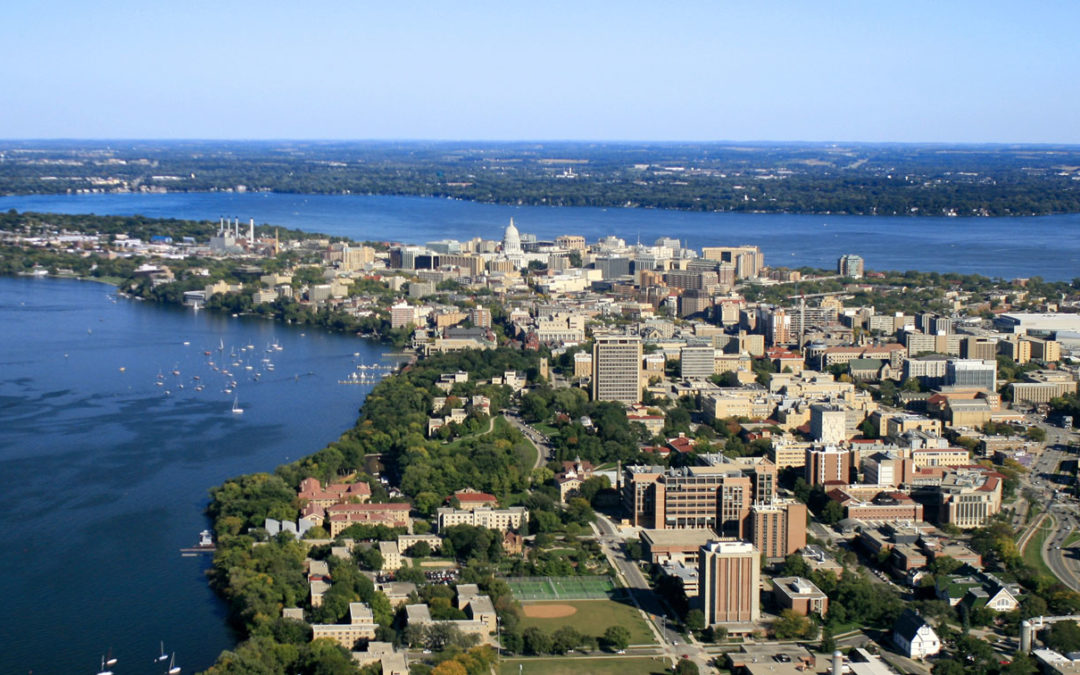
by Michael Vickerman | Mar 28, 2019 | Local Government, Local Initiatives, Renewables, Sustainability
The Madison Common Council adopted in late March a resolution setting 2030 as the deadline to achieve a 100% renewable energy and net-zero carbon goal for city operations. Spearheaded by the Sustainable Madison Committee (SMC), the resolution empowers city staff to lead by example and initiate aggressive policies and practices designed to reduce carbon emissions across the community.
Madison’s action comes on the heels of similar resolutions adopted by its neighbors, specifically the cities of Fitchburg and Monona, committing themselves to procure renewable energy sources to power their operations.
In late February Fitchburg’s Common Council resolved to offset 100% of the city’s electricity demands from renewable energy resources by 2030. A week later, Monona adopted a resolution establishing an identical goal and deadline for its own electricity use, and coupled it with a renewable energy commitment by 2040 applicable to other energy uses, such as heating buildings and fueling vehicles.
With these resolutions on the books, there are now five Wisconsin cities that have embraced a 100% renewable energy (or electricity) future for its operations, and have set deadlines for achieving it. The other two cities on that list are Eau Claire and Middleton (see comparison here).
Adopted on March 19, 2019, Madison’s resolution emerged from a report commissioned by the city in March 2017 to analyze three different scenarios for achieving 100% renewable energy use and net zero carbon emissions. Of the three scenarios examined in the HGA/Navigant report, the SMC selected the 2030 pathway (Scenario 3), after a spirited discussion to identify certain implementation steps necessary to ensure that all City residents benefit from this transition.
The resolution commits city staff to engage “committees and commissions to review and develop plans for policies, programs, and procedures to achieve the goals and targets in Scenario 3.” Between now and the end of the summer, SMC members will work with the relevant committees and commissions to shape and guide these implementation plans. These plans will be submitted in September.
The HGA/Navigant report estimated $95 million in up-front investments over 12 years to achieve the City’s 2030 carbon reduction goals. Under Scenario 3, a combination of heightened building energy efficiency, additional supplies of renewable energy, and an increasingly electrified vehicle fleet produced the broadest array of benefits for city residents, including lower operating budgets and reductions in health-related expenses. According to HGA/Navigant, the social and economic benefits from this transition, coupled with the energy savings, would far surpass the original investment.
At $60 million, the investment in electric buses shapes up to be the costliest element among the strategies analyzed, but one likeliest to yield substantial health benefits to the entire community.
Already, the City of Madison has committed to provide nearly $1.4 million in project financing to leverage the construction of five solar arrays in western Wisconsin totaling 10 MWac. Construction has already begun on these arrays, and all will begin generating power this summer, enough to offset 37% of the City’s electric load on an annual basis. The arrays, owned by BluEarth and developed by OneEnergy Renewables, will serve the municipal utilities of Argyle, Cumberland, Elroy, Fennimore, and New Lisbon.
(Note: See images of BluEarth projects under construction.)
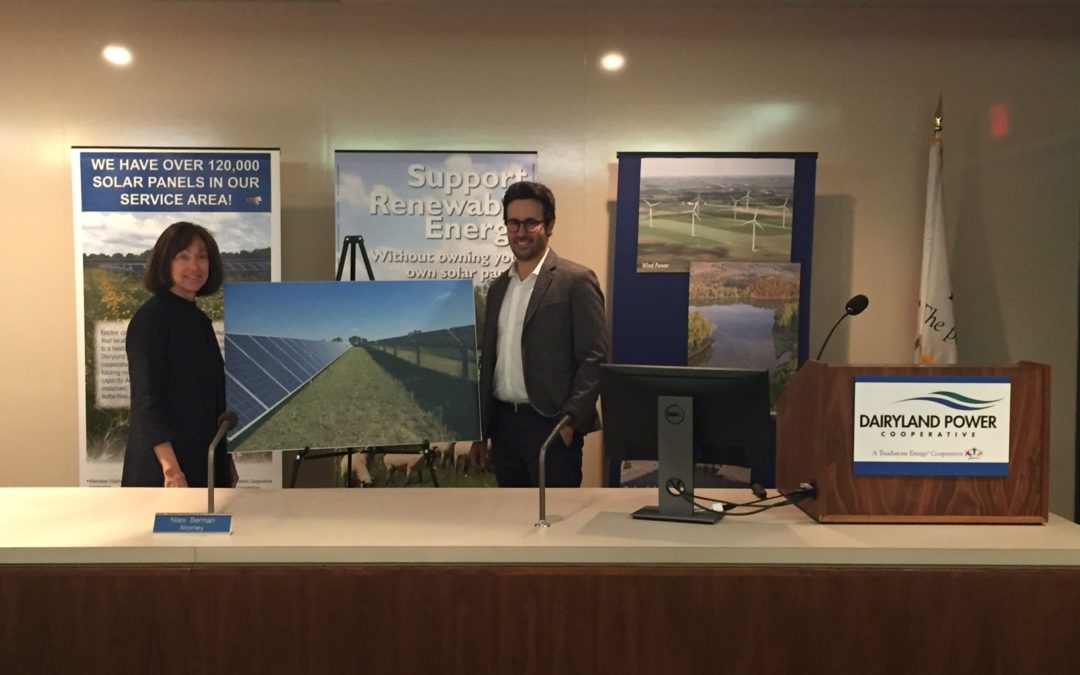
by Tyler Huebner | Mar 18, 2019 | Renewables, Solar, Utilities
Today at their headquarters in La Crosse, Dairyland Power Cooperative announced that it will be purchasing electricity from a major new Wisconsin-based solar energy facility being developed by Ranger Power.
The partnership involves a 149 megawatt solar power facility called Badger State Solar which is planned to be located in Jefferson County, Wisconsin. Ranger Power is planning to develop, own, and operate the project. Dairyland Power Cooperative will purchase all the electricity generated from the project through a long-term power purchase agreement.
The project will produce enough electricity to provide the equivalent annual needs of about 20,000 homes. If all approvals are granted from local and state permitting processes, construction would begin in 2020 and operation would commence in 2022.
RENEW Wisconsin’s Executive Director Tyler Huebner said, “Today’s announcement shows that solar power has become a cost-effective resource for Wisconsin’s major power providers such as Dairyland Power. By committing to this solar project which will be built right here in Wisconsin, Dairyland will meet its goals of a safe, reliable, affordable, and increasingly sustainable and diversified energy supply. We congratulate Dairyland Power Cooperative and Ranger Power on this historic announcement!”
By RENEW Wisconsin’s count, the state had about 103 megawatts of solar at year-end 2018, with Dairyland Power Cooperative responsible for about 20 megawatts, already placing it as the leader in the state for the amount of solar installed to-date. This project, along with a number of additional major solar projects, will dramatically increase the amount of solar energy produced in Wisconsin in the next five years.
More information about the project is included in the links below.
Dairyland Power Press Release
Badger State Solar Project Fact Sheet
Badger State Solar Project Economic Impact
Featured in image: Dairyland Power President and CEO Barb Nick and Ranger Power CEO Paul Harris








